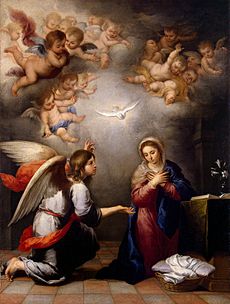Nativity of Jesus facts for kids
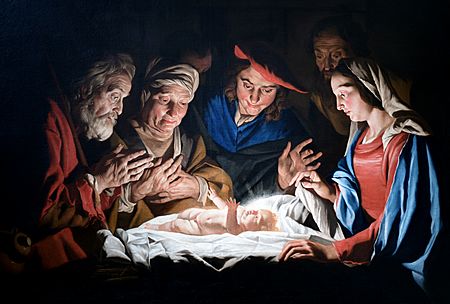
The Nativity is the story of the birth of Jesus Christ. This story is found in the New Testament of the Bible, in the gospels of Matthew and Luke.
The two accounts tell us that Jesus was born in Bethlehem. His mother, Mary, was engaged to a man named Joseph. The gospels say that Joseph was a descendant of the great King David but was not Jesus's biological father. They teach that Jesus's birth was the result of a miracle from God.
The story of the Nativity is the reason Christians celebrate Christmas. It is a very important part of the Christian year. Many people display small statues called a manger scene in their homes to show what the birth of Jesus might have looked like. Schools and churches often put on Nativity plays, where children act out the story. In some countries, large, life-sized Nativity scenes are set up in public places during the Christmas season.
Artists have been creating art about the Nativity for centuries. These paintings and sculptures often show Jesus as a humble and gentle baby. This helped people see Jesus as a kind and loving figure, not just a powerful king.
Contents
The Story in the Gospels
The Gospels of Matthew and Luke are the only two books in the Bible that tell the story of Jesus's birth. While the stories are different, they agree on several key points:
- Jesus was born in the town of Bethlehem.
- His mother's name was Mary.
- Mary's husband, Joseph, was a descendant of King David.
- Jesus's birth was considered a divine miracle.
However, the two stories focus on different people and events. Matthew's story is told more from Joseph's point of view, while Luke's story focuses more on Mary.
The Gospel of Matthew
An Angel Visits Joseph
According to Matthew, Mary was engaged to Joseph when she became pregnant. Joseph was confused and planned to end the engagement quietly. But an angel appeared to him in a dream. The angel told Joseph not to be afraid and to marry Mary. The angel explained that the child was from the Holy Spirit and that he should be named Jesus, because he would "save his people from their sins."
Joseph trusted the angel. He married Mary and took care of her. When the baby boy was born, Joseph named him Jesus.
The Visit of the Magi
Jesus was born in Bethlehem during the time when Herod the Great was king. At that time, wise men from the East, known as the Magi, saw a special star in the sky. They knew this star signaled the birth of a new king, so they traveled to Jerusalem to find him.
King Herod heard about the Magi and their search for a newborn king. He was worried that this new king would threaten his power. He called the Magi and told them to find the child and report back to him. The Magi followed the star to Bethlehem, where it stopped over the house where Jesus was.
They were filled with joy when they found the child with his mother, Mary. They knelt and worshipped him, offering him precious gifts: gold, frankincense, and myrrh. After their visit, an angel warned the Magi in a dream not to return to King Herod. So, they took a different route home.
The Escape to Egypt
When King Herod realized the Magi had tricked him, he became very angry. He ordered a terrible act in Bethlehem to get rid of the new king.
But an angel had warned Joseph in another dream. The angel told him to take Mary and Jesus and flee to Egypt to be safe. The Holy Family stayed in Egypt until King Herod died.
After Herod's death, an angel told Joseph it was safe to return to Israel. They traveled back and settled in the town of Nazareth in the region of Galilee.
The Gospel of Luke
An Angel Visits Mary
Luke's gospel begins the story in the town of Nazareth. God sent the angel Gabriel to visit Mary, who was a young woman engaged to Joseph. The angel told her that she would have a son, that she should name him Jesus, and that he would be the son of God. This event is known as the Annunciation.
The Journey to Bethlehem
Around the time Mary's baby was due, the Roman Emperor, Caesar Augustus, ordered a census. This meant everyone had to travel back to their hometown to be counted. Since Joseph was a descendant of King David, he had to go to Bethlehem, David's ancient city.
Joseph traveled with Mary from Nazareth to Bethlehem. When they arrived, the town was so crowded that there was no room for them in the inn. Mary gave birth to Jesus in a humble place, likely a stable, and she laid the newborn baby in a manger, which is a feeding trough for animals.
The Shepherds
On the night Jesus was born, a group of shepherds were watching their flocks in the fields near Bethlehem. Suddenly, an angel appeared and told them the good news: a Savior had been born in Bethlehem. Then, a huge group of angels appeared, praising God.
The shepherds hurried into the town to find the baby. They found Mary, Joseph, and the infant Jesus lying in the manger, just as the angel had said. They were amazed and went back to their fields, telling everyone what they had seen.
Presentation in the Temple
Forty days after his birth, Mary and Joseph took Jesus to the Temple in Jerusalem to present him to God, as was the Jewish custom. There, they met two elderly, faithful people named Simeon and Anna the Prophetess. Both recognized Jesus as the promised Savior and gave thanks to God. After this, the family returned home to Nazareth.
Place and Date of Birth

Both Matthew and Luke agree that Jesus was born in Bethlehem. A very old tradition says he was born in a cave that was used as a stable. Today, the Church of the Nativity, one of the oldest churches in the world, stands over this spot.
The exact date of Jesus's birth is not mentioned in the Bible. The celebration of Christmas on December 25th was established centuries later. Historians estimate that Jesus was likely born between 6 BC and 4 BC, based on the time of King Herod's reign.
What the Nativity Means to Christians
The Nativity is more than just a story for Christians; it is full of deep meaning.
A New Beginning
Many Christian thinkers, like the early leader Paul the Apostle, saw the birth of Jesus as a new beginning for humanity. In the Bible's Old Testament, the story of Adam and Eve explains how sin and disobedience entered the world. Christians believe that Jesus, through his perfect obedience to God, fixed the damage caused by Adam's disobedience.
For this reason, Jesus is sometimes called the "second Adam" or the "new man." His birth is seen as the start of a new relationship between God and people, one based on love and salvation.
The Nature of Jesus
The Nativity is also central to the Christian belief about who Jesus is. Christians believe that Jesus is unique because he is both fully human and fully divine (God). The story of his birth to a human mother, Mary, shows his human side. The story of his miraculous conception by the Holy Spirit shows his divine side.
This idea, that Jesus is both God and man, is a core belief in Christianity. The story of his humble birth—the Son of God born in a simple stable—is a powerful symbol of God's love and humility.
How the Nativity is Celebrated
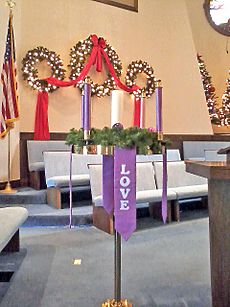
Christmas
The main celebration of the Nativity is Christmas, which is a major holiday for Christians and a cultural celebration for many others around the world. Most Western churches celebrate Christmas on December 25. Many Eastern Orthodox Churches celebrate it on January 7, because they use an older calendar called the Julian calendar.
The season leading up to Christmas is called Advent. For many Christians, it is a time of preparation and waiting. Traditions during the Christmas season include:
- Lighting candles on an Advent wreath.
- Singing Christmas carols.
- Giving gifts to friends and family.
- Attending special church services.
- Decorating homes with lights, Christmas trees, and Nativity scenes.
Nativity Scenes and Plays
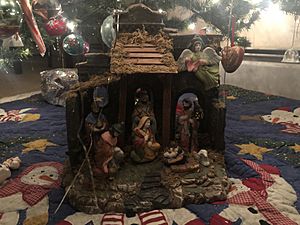
One of the most popular traditions is the Nativity scene, also called a manger scene or a crèche. These displays show the baby Jesus in the manger, surrounded by Mary, Joseph, shepherds, angels, and animals. Sometimes, the Magi and their camels are also included.
This tradition was made popular by Francis of Assisi in 1223. He wanted to help people imagine the humble setting of Jesus's birth. He created a living Nativity scene with real people and animals to remind everyone of the poverty and simplicity of that first Christmas.
Many schools and churches also perform Nativity plays, where children dress up as the characters and act out the story of Jesus's birth.
The Nativity in Art and Music
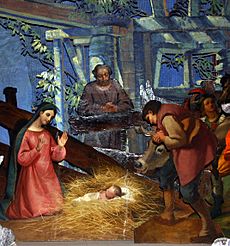
The story of the Nativity has inspired countless works of art, music, and literature for nearly 2,000 years.
Art
The earliest paintings of the Nativity were found in the catacombs of Rome, ancient underground burial sites. Over the centuries, it became one of the most common subjects in Christian art. Artists have depicted the scene in paintings, sculptures, stained glass windows, and icons. These artworks often show the peace and holiness of the event, with a gentle light shining from the baby Jesus.
Music and Hymns
Many of the world's most famous pieces of music are about the Nativity. The Gospel of Luke contains four beautiful songs, or canticles, that are still used in church services today:
- The Magnificat (Mary's song of praise).
- The Benedictus (the song of Zechariah, father of John the Baptist).
- The Gloria in Excelsis (the song of the angels to the shepherds).
- The Nunc dimittis (Simeon's song when he sees the baby Jesus).
Christmas carols are songs that tell parts of the Nativity story. Some of the oldest and most beloved carols, like "Silent Night" and "O Holy Night," focus on the peaceful and miraculous birth of Jesus. Composers like Johann Sebastian Bach and George Frideric Handel also wrote famous classical works, called oratorios, that tell the Christmas story through music.
- Christ Child
- Chronology of Jesus
- Jesus in Christianity
- Life of Jesus in the New Testament
- Marian art in the Catholic Church
- Matthew 2:23
- Nativity of Mary
- Nativity of Saint John the Baptist
- Race and appearance of Jesus
- Saint Joseph's dreams
See also
 In Spanish: Natividad de Jesús para niños
In Spanish: Natividad de Jesús para niños



